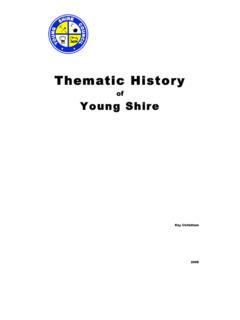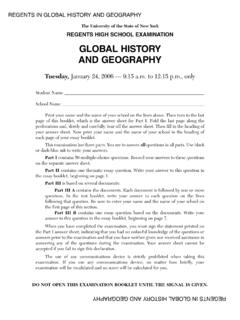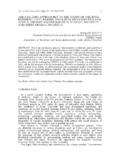Transcription of A BRIEF HISTORY OF CHEMISTRY - Waldorf …
1 A BRIEF HISTORY . OF. CHEMISTRY . by Michael Ridenour A Curriculum Study Research Institute for Waldorf Education Copyright 2004 by Michael Ridenour All Rights Reserved 1. Chapter Outlines Preface 4. Origins: The foundation for much of modern thought was laid in the science and philosophy of ancient Egypt and classical Greece. The chapter will compare ancient and modern and address the changes that led from one to the other. In Egypt: the land of Chem, myth and legend, the three gifts of Hermes Trismegistus and the doctrine of as above so below. The times change but we share a need to understand the nature of substance with older cultures.
2 The science of substance has a dark side: Frank Oppenheimer's concern during the making of the first atomic bomb and the blind rush to get this thing to go. Contrasts in classical and modern thought, deductive and inductive reasoning. Greek philosophy and parallels to modern thought. Medieval alchemy and the Philosopher's Stone. Paracelsus the man and scientist. The advent of experimental medicine begins to break free of the philosophical school of science. Becher and the last fires of alchemy. Mithridates, saturated with poison. The ever puzzling mystery of fire gives rise to the theory of phlogiston.
3 9. Transition Theories: The seventeenth century: a time of turmoil, war and the fire of new Ideas lead to the birth of empirical science. Georg Stahl and phlogiston theory, the search for the evidence of things unseen. Problems with the theory. The alkali theory of opposites, shades of Empedocles. But no one knew what an acid was! The qualitative meaning of force and the efforts of the empiricists to do away with the offending word. The atom seen by Democritus. Epicurus develops an atomic theory of free will. Lucretius' poem On the Nature of Things popularizes the atomism of Epicurus.
4 Chance as a precursor to probability. Ren Descartes espouses the mechanical model. Empirical science has a new advocate in Robert Boyle. Robert Boyle and the mechanical model. Nature abhors a vacuum. Boyle applies the new science of atoms to explain the expansion of air to fit any size container. Deism and the Cartesian .. 23. A New Science is Born: The Age of Enlightenment, despotism, exploration, new ideas and an abiding faith in reason continue the transition toward a more empirical science. Joseph Priestley the dissenting minister with a quaint hobby.
5 Smelling vapors at the brewery. Meeting with Benjamin Franklin inspires a study of electricity. Acceptance into the Royal Society. The first Club Soda. Preliminary work with the oxides of nitrogen. A fortuitous incident sparks his greatest discovery. One mouse survives but Aristotle's element of air (and water) does not. Meeting house burned. Fed up with England, Priestley joins his sons in America where he continues his research. Cavendish, the misanthropic aristocrat, discovers the fiery complement to Priestley's dephlogisticated air. The chemical composition of water.
6 The curious ways of simultaneous discovery was something in the air? .30. 2. Laying the Corner Stone: It is the best of times and it is the worst of times for CHEMISTRY . Lavoisier and the foundation of a modern science. Gypsum and fixed water anticipate the phenomenon of fixed air. Persistent contradictions in phlogiston theory raise fresh doubts. Priestley's visit to France and his meeting with Lavoisier. The twelve day experiment. The mystery of phlogiston is solved. Oxygen is born. The Treatise of the Elements of CHEMISTRY defines an element and provides a new system of naming elements and compounds.
7 Tragedy at the hands of an old enemy meets the guillotine 38. Laying the Foundation: An Interlude: the French chemist and historian, Marcellin Berthelot, laments the overpowering and degrading influence of empirical science. He fears that the world has lost its moral direction; the notion of the miraculous and the supernatural have vanished like a vain mirage It has become a noisy world and to help make it meaningful a selection from T. S. Eliot's poem, Four Quartets, offers an image of the Chinese jar. The stillness as a Chinese jar is still moves perpetually in its stillness not the stillness of the violin while the note lasts and the end and the beginning were always there before the beginning and after the end This will become the central metaphor for the rest of the book.
8 The Birth of Modern Atomic Theory: John Dalton, humble Quaker schoolmaster and man of the hour, finds a world ready for the atom. The uniform composition of the atmosphere explained. Proust and the law of constant proportions. Galvani's frog legs leap onto the voltaic pile. Electricity becomes the tool of the times. Humphry Davy and the discovery of alkali and alkali earth metals. Berzelius and the electro-chemical theory of bonding. A new table of atomic weights and new nomenclature to boot! Gay Lussac and the law of volumes. Conflict between Dalton's theory and experimental results with the gases.
9 William Prout and the quest for primordial substance. Parmenides, here we come ..44. The Search for Order: Enter, the 19th century. A shabby entry full of confusion and argument suggests much drama lies in store. A tale of some tragedy: Avogadro's hypothesis and how it applied to gases conflicts with the electro-chemical theory of bonding. The Karlsruhe conference of 1861. Cannizaro passes out Avogadro's hypothesis at the conference. Julius Lothar Meyer: the scales dropped from my eyes! Newland's law of octaves gets the Royal Society version of the Bronx Cheer.
10 Meyer's Periodicity of the elements based on physical properties attracts attention. Mendelyev's periodic table and the successful prediction of undiscovered elements clinches the deal. Intimations of Pythagoras. The nature of chemical bonds, polar and co-valent. Electro- CHEMISTRY and the ions of Arrhenias. Michael Faraday's holistic view of the electro- magnetic field offer an alternative explanation for ions. New discoveries suggest mysterious relationships between matter and energy .. 53. 3. And the Violin Plays On: Revolutionary finds in physics shake the complacent world of science.










